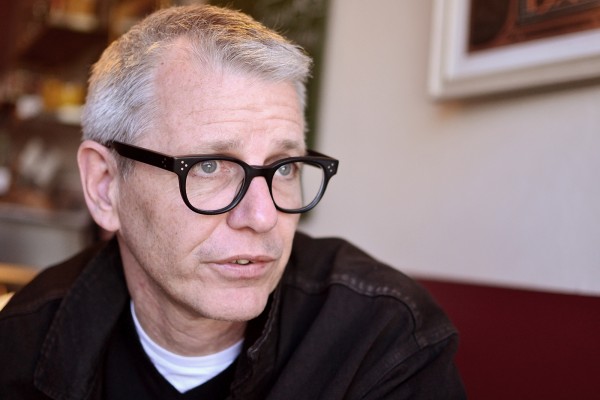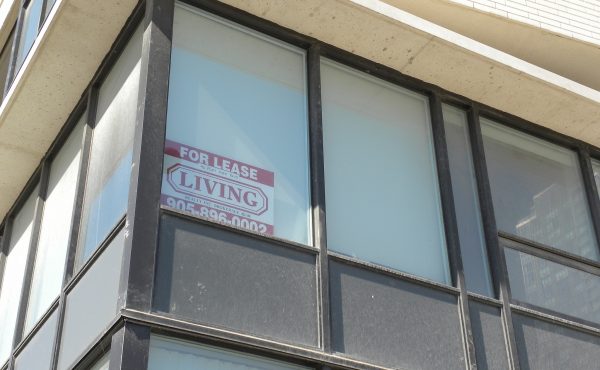Anyone who’s spent even a few minutes in the company of Adam Vaughan knows that the two-term councilor for Trinity-Spadina is about as close to a walking encyclopedia of urbanism as you can find in this city, or any other city for that matter. Flip the `on’ switch, and Vaughan will dispense lengthy and mind-bogglingly detailed accounts of just about any municipal issue – everything from transit to public space to policing to the psycho-socio-spatial dimensions of poverty.
But his passion is and has always been housing: how to build it, where to build it, what form to build it in, who to build it for, and how to find ways to create affordable homes for those city-dwellers whose incomes never stretch far enough. “That’s why I’m in politics,” he says in an uncharacteristically short sentence.
To take the most high-minded interpretation of the latest twist in Vaughan’s meandering career (cartoonist, campus radio host, television journalist, politician), Justin Trudeau and his merry band of Liberals came ‘a callin’ last week because they want to leverage his copious knowledge of cities as part of their election strategy.
In an interview with Spacing on Sunday, Vaughan said that when Trudeau and chief of staff Gerald Butts made their widely-reported but abrupt overture, he agreed to seek the Trinity-Spadina nomination on one key condition: if he wins the contest (and the eventual by-election), he will head a caucus committee tasked with developing a national urban agenda for the Liberals for the next election and beyond.
Trudeau, Vaughan said, sounded like a politician who gets the complexity of the modern Canadian city, and gets it because his own Montreal riding includes extremes of wealth and poverty, ethno-cultural diversity, and all the challenges that come with building a metropolis suited to the needs of such a population.
Though a long-standing independent on council, Vaughan’s family has history with the Grits: father Colin (campaign organizer, architect, politician, activist, broadcaster) was a card-carrying Liberal until he had a falling out, in the late 1960s, with Trudeau pérè over the latter’s unwillingness to assert the federal government’s interest in Canada’s cities.
After that split, Colin Vaughan, as history shows, immersed himself in the Spadina expressway fight and made common cause with the provincial Tories. Trudeau, in the meantime, went on to establish a federal ministry of state of urban affairs, a short-lived affair that achieved little more than a few showcase projects.
Despite the failure of MUSA, the Liberals in the two generations since have regarded Canada’s cities as fertile ground politically, commanding the electoral loyalties of millions of immigrants. In the mid-to-late 1990s, several key figures in Jean Chretien’s caucus and cabinet (including former Toronto mayor Art Eggleton and Winnipeg power-broker Lloyd Axworthy) had extensive municipal/big city ties. They lobbied successfully for the first tranche of infrastructure funds, and then pushed for a more coherent federal strategy on issues like housing and transit.
When finance minister Paul Martin managed to usher Chretien to the exit, he embarked on the so-called New Deal for Cities, a campaign designed to transfer more federal dollars to municipalities hurt by provincial downloading. Pushed along by the late NDP leader Jack Layton, Martin established a federal gas tax and a new cabinet post (minister of cities and communities). After emerging from the 2004 election with a minority, Layton and Martin passed a landmark budget that included huge sums for housing, transit and green energy.
Then something odd happened on the way to the Forum. The Harper Tories, elected in 2006 as a minority government, moved to re-package the Liberals’ urban agenda, but they certainly didn’t gut it. Over the years, the Tories have kept growing their infrastructure fund, and they’ve gone out of their way to court newcomers, especially those who settle in the newer suburbs around Canada’s biggest cities.
So let’s set aside, for the moment, the cynical interpretation of Trudeau fils’ decision to romance Vaughan (i.e., tapping a high-visibility urban pol who can swipe Olivia Chow’s old seat).
Let’s assume Trudeau really does want to be intellectually and politically competitive in a space that the NDP have already targeted (i.e., Beaches East-York MP Matthew Kelway’s urban white paper). The policy challenge facing Vaughan will be to cobble together a program that is innovative, financially achievable, consistent with the localism principles he espouses as a municipal politician, and something more than a thinly veiled attempt to generalize Toronto’s particular problems on a national scale.
Yet those with long-ish memories can point to other worthy Liberal urban initiatives that died on the vine – e.g., a 1990 housing strategy concocted by then leadership candidate Paul Martin and London MP Joe Fontana. The blueprint, remarked University of Toronto sociologist David Hulchanski, “was released after extensive national consultation in May, 1990. Its analysis and 25 recommendations form an excellent basis for a comprehensive national housing strategy.”
On that note, Vaughan — who pledges to resign his council seat if he wins the Trinity-Spadina Liberal nomination — says he’s been disappointed by the lack of debate in the mayoral race about housing issues. So it’s not surprising that he bit at the opportunity to pursue his animating political passion at the federal level.
What remains to be seen is whether Trudeau and his political braintrust actually intend to tap into that wealth of urban knowledge between Vaughan’s ears, or if they’re merely after his surname and his voter contact list. Given the chance, Vaughan will throw himself into this assignment. Here’s hoping he’ll be rewarded in a way that eluded his equally passionate and urban-minded father.






13 comments
Liberal run from left, govern from right. Ask Gerard Kennedy, Carolyn Bennett, Ken Dryden. Vaughan is being used.
Used?!? Vaughn is a political opportunist to his core, Urbanism is just the banner he waves in the service self promotion.
With much of the former Quebec Liberal caucus fleeing to the NDP, I am hoping urban liberal MPs become the voice of the party.
Affordable housing advocate!?!? – this guy’s Section 37 extortion adds thousands of dollars a condo unit to the most affordable housing option in the City – with the benefits generally going to neighbourhoods with some of Canada’s highest home values. Glad to see him gone from City Hall and looking forward to voting for who ever the NDP put up.
Adam’s jump to Ottawa is timely and necessary. We need to have urbanists who will generate policy, debate, and legislation that will feed the urban landscape of this country. For too long the 2 governing federal parties have failed miserably to right their wrongs. Who has the temerity to say that the dismantling of the affordable housing program was the best thing for citizens of Canada. It was a deeply vile, corrosive act by Chretien’s government in 1993 followed by Harris in Ontario in 1996. Transit is in desperate need across this country, but senior governments look away. Adam will bludgeon the insiders in the Liberal party who fail to advance the principles that need to distinguish the Grits from the Tories. For too long they have both been hegemonists of neo-liberal destruction of this country. Kick their asses, Adam
@Jamie / Kyle (maybe the same person?):
“Vaughn is a political opportunist to his core, Urbanism is just the banner he waves in the service self promotion.”
A political opportunist is one that changes their politics to advance their own political career. Vaughan was elected in 2006 on a platform of building more low-income (and family) housing, and that’s what he’s done (look it up). He has always been an urbanist. Perhaps you’re thinking about Mammoliti?
“this guy’s Section 37 extortion adds thousands of dollars a condo unit to the most affordable housing option in the City – with the benefits generally going to neighbourhoods with some of Canada’s highest home values.”
Citation? That argument stinks. Section 37 provides a means for developers to pay for infrastructure improvements to the community *in which their building will be situated*. The benefits are to those people who will move into that area. While it’s not a perfect system, it’s undoubtedly useful. It’s certainly *not* extortion (that bogus claim is straight out of Rob Ford’s mouth), and I see no evidence to show that section 37 payments add thousands of dollars to the price of condominiums. I can see how you’d think this might be true, but rising prices for property are much more likely due to high demand for real estate.
If you’re looking for a bogey-man to blame for the high cost of housing in Toronto, I’d look elsewhere.
During Adam Vaughan’s time in Council, my opinion on him has changed quite a bit. From vitriol fueled several public feuds where he and I were quoted on opposite sides of the Entertainment District debate, to great admiration for his ideology and passion.
That said, I will be really glad to see his nightlife meddling gone from the local discussion if he wins.
Where do you think the Section 37 money comes from? Greedy developers decide to sell their Second Ferrari?
Why should a new home buyer take on additional debt to pay for: (these are not Vaughan)
$100,000: Scar Animal Centre improvements such as Dog Kennel Construction Project
$20,000: Scarborough flags for municipal and civic purposes by City and Councillor.
$100,000: Scarborough Walk of Fame.
From your analysis it is obvious that you don’t have the experience to know if it is extortion or not. But it is fun to comment on stuff you are ignorant about.
@Not Jamie
Section 37 trades off extra building height (i.e. more units for the developer) with community benefits (i.e. cash to pay for things listed in the City’s Official Plan). So the money comes from the profits the developer makes on the additional units.
Something that adds a much larger chunk to condo costs is underground parking spaces (i.e. $30k per space). Adam Vaughan has fairly consistently supported reductions in the amount of parking spaces required for developments in his ward.
Also why are you listing things Section 37 money is spent on in other wards? If you’re arguing against Vaughan’s use of s37, then you need to list inappropriate things that he has directed that money towards in his ward.
The argument that section 37 increases the cost of a condo is pretty naive about how development works. Developers charge the maximum they think buyers will pay, not the costs they incur plus a fixed markup. Construction costs and soft costs (architects, lawyers, engineers, etc) are all fairly fixed, plus whatever the gov’t charges and land costs are. If these numbers are not sufficiently below what they think they can sell the condos for, they don’t build the building. Either sales prices rise to the point where construction makes sense, or land values decline such that developers can once again make a profit.
The idea that section 37 is incompatible with affordable housing is ridiculous (not to say section 37 isn’t rife with problems.
This was an absolutely brilliant move by the Liberals. It totally caught the NDP off guard who thought they had it in the bag. According to the Forum Poll of Trinity-Spadina Vaughan takes about a third of the NDP vote if he’s the candidate and wins easily.
Joe Cressy is frankly some party apparatchik. The Trinity-Spadina NDP needed to reach out not run the best man at Mike Layton’s wedding and the former president of the RA who has been positioning himself for this position for a long time.
It also sounds like Vaughan is going to be given a fair amount of independence for a partisan campaign – not saying Trudeau won’t be in the campaign – he’ll certainly will – but since there’s no platforms Vaughan will be largely allowed to write the script. The Liberals are shoring up their left flank to compete on the NDP’s turf. So Vaughan will be able to talk about housing and city issues and be able to say he will be a leading figure on the national stage in this front.
In contrast, Joe Cressy isn’t strong enough so it’ll basically be a “let’s keep Olivia’s riding in NDP hands” campaign. It’ll be very much a scripted, centralized campaign written by party HQ, saying that Tom Mulcair has substance and Justin Trudeau is a lightweight. Nor would Cressy play an important role in the NDP caucus as there are many more talented people there.
As for the Liberals using Vaughan or what influence will he have – I am pessimistic. I think Vaughan is going to feel very constrained in Ottawa.
Over the last 13 years there’s been an explosion of condo developments in Adam Vaughan’s ridding, with more to come. Nearly all of these condo units are 1 bedroom, basement apartments in the sky. A couple can live in these units, but they can’t grow into them with a family. Once their first child comes they have to move out and find a home with more space.
Where you believe Government should build more social housing or not, or let the free market run un-tethered (which is what happened), there was an incredible opportunity to build family housing (condo or single family) that has now been lost.
So I don’t know how Adam Vaughan be a champion of social housing or urban planning when his ward presided over the largest residential development since the second world war, only to have it produced 100,000 one bedroom apartments.
Just a couple of quick points on Section 37; This part of the planning act is not just a way of securing funding to shoulder growth in areas or projects that see an increase in density. Section 37 agreements also secure family size housing and affordable housing. If you look at the planning reports required as part of any development that moves through council you can see how it used. On family housing for example, before I took office, 98% of all the units approved in Trinity-Spadina were one bedroom units (no room for a child or an aging parent). Every project since I took office has included a requirement that 10% of all units be 3 bedroom plus in size. Close to 2000 units of family housing have been built of approved south of Queen Street alone. We also required all other units to have knockout panels so that in the future flexibility was built into the buildings and larger units could be created. As a result Ward 20 has led the way in seeing more children and families in its condominium neighbourhoods. The numbers are borne out (literally borne out!) in a report from planning. Additionally, at a minimum, all Sec 37 agreements We negotiated included that at least 10% be set aside for public housing repairs and new construction. The money was distributed through a participatory budgeting process unique to Trinity Spadina. Dozens more of those agreements set aside the full amount to build affordable housing in their entirety. We also used section 37 in the rail lands to build a new Library next to a new TCHC building, a new arts centre for youth across the street and a community centre and day care are now getting started. In Alex Park the Section 37 agreements will create thousands of square metres of new non-profit commercial space young people and existing families to start new businesses and create opportunities in the local community. The Section 37 agreements also secure an employment programme for young people on the rebuild.
In the end, two neighbourhood revitalizations of TCHC communities were started in Trinity Spadina during my term, both are using section 37 funds to bring social, cultural, environmental and economic change to the neighbourhoods that are being rebuilt. We have also used the funds to start a dozen other housing opportunities. Some projects will see affordable rental housing for working families built right into new condo projects. Worker housing in a hotel, supportive housing, artists housing, student housing, faculty housing, co-op housing and affordable home ownership experiments are all part of the programme we have developed in Trinity Spadina. We have also used Section 37 to relocate and help build the Eva’s Phoenix youth shelter in the ward. With Federal support we could be housing thousands of people and families more. Councillors like Kristyn Wong Tam have followed our lead. Sadly others have not. If all councillor’s had set aside just 10% of every section 37 agreement since amalgamation there would not be a capital backlog at TCHC.
To their credit neighbourhoods like the Annex and Harbord Village have stepped up, not only did they insist on inclusionary zoning for new projects in their community. These neighbours have championed the idea of leveraging the development that is happening to help solve the housing crisis we have, they were also staunch allies in the fight to keep TCHC scattered housing and save great communities like the Hydro Block from being sold to repair housing. residents in the Annex are heavily engaged with the revitalization of 250 Davenport, and Harbord Village helps sponsor scholarship programmes in Alex Park.
Again, imagine if we had a government in Ottawa that used it’s capacity to partner with the city and residents to deliver more. The housing challenge can be met. All we need to do is decide to solve the problem instead of pointing fingers and protesting inaction. Time for change.
av